Quote:
Originally Posted by creeposaurus

NOPE
Post it again Thrash, I forgot
|
WAIKT BETTER HERS STUFF THAT I KNOW ABOUT EUROPE BECAUSE THATS WHERE AKLL THE KINGS AND GUYS ARE I WROTE THIS THIS IS WHAT I KNOW ABOUT EUROPE
Europe (
pronunciation: /ˈjʊəɹəp/ yewr-əp; /ˈjuɹəp/ or /ˈjəɹəp/ yur-əp[1]) is, by convention, one of the world's seven continents. Comprising the westernmost
peninsula of
Eurasia, Europe is generally
'divided' from
Asia to its east by the
watershed divides of the
Ural and
Caucasus Mountains, the
Ural River, the
Caspian and
Black Seas, and the
waterways connecting the Black and
Aegean Seas.
[2] Europe is bordered by the
Arctic Ocean and other bodies of water to the north, the
Atlantic Ocean to the west, the
Mediterranean Sea to the south, and the Black Sea and connected waterways to the southeast. Yet the borders of Europe—a concept dating back to
classical antiquity—are somewhat arbitrary, as the primarily
physiographic term "continent" can incorporate
cultural and political elements.
Europe is the world's
second-smallest continent by surface area, covering about 10,180,000 square kilometres (3,930,000 sq mi) or 2% of the Earth's surface and about 6.8% of its land area. Of Europe's approximately 50 states,
Russia is the largest by both area and population (although the country has territory in both Europe and Asia), while the
Vatican City is the smallest. Europe is the third-most populous continent after Asia and
Africa, with a
population of 733 million or about 11% of the
world's population.
[3] In 1900, Europe's share of the world's population was 25%.
[4]
Europe, in particular
Ancient Greece, is the birthplace of
Western culture.
[5] It played a predominant role in global affairs from the 16th century onwards, especially after the beginning of
colonialism. Between the 16th and 20th centuries, European nations controlled at various times
the Americas,
most of Africa,
Oceania, and large portions of Asia. Both
World Wars were largely focused upon Europe, greatly contributing to a decline in
Western European dominance in world affairs by the mid-20th century as the
United States and
Soviet Union took prominence.
[6] During the
Cold War, Europe was divided along the
Iron Curtain between
NATO in the west and the
Warsaw Pact in the east.
European integration led to the formation of the
Council of Europe and the
European Union in
Western Europe, both of which have been expanding eastward since the
fall of the Soviet Union in 1991.
Contents
[
hide]
Definition
Further information:
List of countries spanning more than one continent
Further information:
Borders of the continents


Reconstruction of
Herodotus' world map


A medieval
T and O map from 1472 showing the division of the world into 3 continents

 Europa regina
Europa regina map from
Münster (1570). The British Isles and Scandinavia are not included in Europe proper.
The use of the term "Europe" has developed gradually throughout history.
[7][8] In antiquity, the Greek historian
Herodotus mentioned that the world had been divided by unknown persons into the three
continents of Europe, Asia, and Libya (Africa), with the
Nile and the
River Phasis forming their boundaries—though he also states that some considered the
River Don, rather than the Phasis, as the boundary between Europe and Asia.
[9] Europe's eastern frontier was defined in the 1st century by geographer
Strabo at the
River Don[10] Flavius and the
Book of Jubilees described the continents as the lands given by
Noah to his three sons; Europe was defined as stretching from the
Pillars of Hercules at the
Strait of Gibraltar, separating it from Africa, to the
Don, separating it from Asia.
[11]
A cultural definition of Europe as the lands of
Latin Christendom coalesced in the 8th century, signifying the new cultural condominium created through the confluence of Germanic traditions and Christian-Latin culture, defined partly in contrast with
Byzantium and
Islam, and limited to northern Iberia, the British Isles, France, Christianized western Germany, the Alpine regions and northern and central Italy.
[12] The concept is one of the lasting legacies of the
Carolingian Renaissance: "Europa" often figures in the letters of Charlemagne's cultural minister,
Alcuin.
[13] This division—as much cultural as geographical—was used until the
Late Middle Ages, when it was challenged by the
Age of Discovery.
[14][15] The problem of redefining Europe was finally resolved in 1730 when, instead of waterways, the Swedish geographer and cartographer
von Strahlenberg proposed the
Ural Mountains as the most significant eastern boundary, a suggestion that found favour in
Russia and throughout Europe.
[16]
Europe is now generally defined by geographers as the westernmost
peninsula of Eurasia, with its boundaries marked by large bodies of water to the north, west and south; Europe's limits to the far east are usually taken to be the Urals, the
Ural River, and the
Caspian Sea; to the south-east, the
Caucasus Mountains, the
Black Sea and the waterways connecting the Black Sea to the Mediterranean Sea.
[17] Because of sociopolitical and cultural differences, there are various descriptions of Europe's boundary. For example,
Cyprus is approximate to
Anatolia (or Asia Minor), but is often considered part of Europe and currently is a member state of the EU. In addition,
Malta was considered an island of Africa for centuries,
[18] while
Iceland, though nearer to
Greenland (North America), is also generally included in Europe.
Sometimes, the word 'Europe' is used in a geopolitically limiting way
[19] to refer only to the European Union or, even more exclusively, a culturally defined core. On the other hand, the
Council of Europe has 47 member countries, and only 27 member states are in the EU.
[20] In addition, people living in insular areas such as
Ireland, the
United Kingdom, the
North Atlantic and
Mediterranean islands and also in
Scandinavia may routinely refer to
"continental" or "mainland" Europe simply as Europe or "the Continent".
[21]
Clickable map of Europe, showing one of the most commonly used continental boundaries[22]
Key: blue: states which straddle the border between Europe and Asia; green: states not geographically in Europe, but closely associated politically[23]
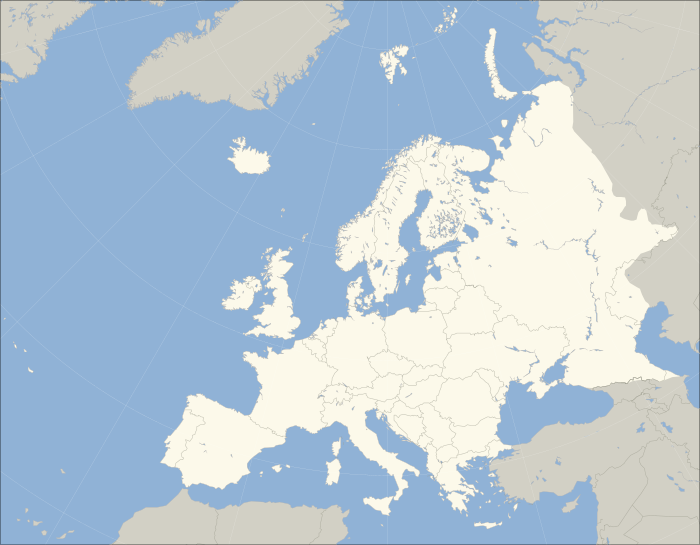 Etymology
Etymology
In ancient
Greek mythology,
Europa was a
Phoenician princess whom
Zeus abducted after assuming the form of a dazzling white bull. He took her to the island of
Crete where she gave birth to
Minos,
Rhadamanthus and
Sarpedon. For
Homer, Europe (
Greek: Εὐρώπη,
Eurṓpē; see also
List of Greek place names) was a mythological queen of Crete, not a geographical designation. Later,
Europa stood for
central-north Greece, and by 500 BC its meaning had been extended to the lands to the north.
The name of
Europa is of uncertain etymology.
[24] One theory suggests that it is derived from the
Greek roots meaning broad (εὐρ(υ)-
eur(u)-) and eye (ὤψ/ὠπ-/ὀπτ-
ōps/
ōp-/
op(t)-), hence
Eurṓpē, "wide-gazing", "broad of aspect" (compare with
glaukōpis (γλαυκῶπις 'grey-eyed') Athena or
boōpis (βοὠπις 'ox-eyed') Hera).
Broad has been an
epithet of
Earth itself in the reconstructed
Proto-Indo-European religion.
[25] Another theory suggests that it is actually based on a
Semitic word such as the
Akkadian erebu meaning "to go down, set" (cf.
Occident),
[26] cognate to Phoenician
'ereb "evening; west" and Arabic
Maghreb, Hebrew
ma'ariv (see also
Erebus,
PIE *h1regʷos, "darkness"). However, M. L. West states that "phonologically, the match between Europa's name and any form of the Semitic word is very poor".
[27]
Most major world languages use words derived from "Europa" to refer to the "continent" (peninsula). Chinese, for example, uses the word
Ōuzhōu (歐洲), which is an abbreviation of the transliterated name
Ōuluóbā zhōu (歐羅巴洲); this term is also used by the
European Union in
Japanese-language diplomatic relations, despite the
katakana Yōroppa (ヨーロッパ?) being more commonly used. However, in some Turkic languages the originally Persian name
Frangistan (land of the
Franks) is used casually in referring to much of Europe, besides official names such as
Avrupa or
Evropa.
[28]
History
Main article:
History of Europe
Prehistory
Main article:
Prehistoric Europe

 Ġgantija
Ġgantija,
Malta


The
Lady of Vinča, neolithic pottery from
Serbia

 Stonehenge
Stonehenge, a prehistoric monument in the
United Kingdom


The
Nebra sky disk from
Bronze age Germany
Homo georgicus, which lived roughly 1.8 million years ago in
Georgia, is the earliest
hominid to have been discovered in Europe.
[29] Other hominid remains, dating back roughly 1 million years, have been discovered in
Atapuerca,
Spain.
[30] Neanderthal man (named for the
Neandertal valley in
Germany) appeared in Europe 150,000 years ago and disappeared from the fossil record about 30,000 years ago. The Neanderthals were supplanted by modern humans (
Cro-Magnons), who appeared in Europe around 40,000 years ago.
[31]
The
European Neolithic period—marked by the cultivation of crops and the raising of livestock, increased numbers of settlements and the widespread use of pottery—began around 7000 BC in
Greece and the
Balkans, probably influenced by earlier farming practices in
Anatolia and the
Near East. It spread from South Eastern Europe along the valleys of the
Danube and the
Rhine (
Linear Pottery culture) and along the
Mediterranean coast (
Cardial culture). Between 4500 and 3000 BC, these central European neolithic cultures developed further to the west and the north, transmitting newly acquired skills in producing copper artefacts. In Western Europe the Neolithic period was characterized not by large agricultural settlements but by field monuments, such as
causewayed enclosures,
burial mounds and
megalithic tombs.
[32] The
Corded Ware cultural horizon flourished at the transition from the Neolithic to the
Chalcolithic. During this period giant
megalithic monuments, such as the
Megalithic Temples of Malta and
Stonehenge, were constructed throughout Western and Southern Europe.
[33][34] The
European Bronze Age began in the late 3rd millennium BC with the
Beaker culture.
The
European Iron Age began around 800 BC, with the
Hallstatt culture. Iron Age colonisation by the
Phoenicians gave rise to early
Mediterranean cities. Early
Iron Age Italy and
Greece from around the 8th century BC gradually gave rise to historical Classical antiquity.
Classical antiquity
Main article:
Classical antiquity
See also:
Ancient Greece and
Ancient Rome


The Greek Temple of Apollo,
Paestum,
Italy
Ancient Greece had a profound impact on Western civilisation. Western
democratic and
individualistic culture are often attributed to Ancient Greece.
[35] The Greeks invented the
polis, or city-state, which played a fundamental role in their concept of identity.
[36] These Greek political ideals were rediscovered in the late 18th century by European philosophers and idealists. Greece also generated many cultural contributions: in
philosophy,
humanism and
rationalism under
Aristotle,
Socrates and
Plato; in
history with
Herodotus and
Thucydides; in dramatic and narrative verse, starting with the epic poems of
Homer;
[35] and in science with
Pythagoras,
Euclid and
Archimedes.
[37][38][39]


The
Roman Empire at its greatest extent
Another major influence on Europe came from the
Roman Empire which left its mark on
law,
language,
engineering,
architecture, and
government.
[40] During the
pax romana, the Roman Empire expanded to encompass the entire
Mediterranean Basin and much of Europe.
[41]
Stoicism influenced
Roman emperors such as
Hadrian,
Antoninus Pius, and
Marcus Aurelius, who all spent time on the Empire's northern border fighting
Germanic,
Pictish and
Scottish tribes.
[42][43] Christianity was eventually
legitimised by
Constantine I after three centuries of
imperial persecution.
Early Middle Ages
Main articles:
Late Antiquity and
Early Middle Ages
See also:
Dark Ages (historiography) and
Age of Migrations

 Roland
Roland pledges
fealty to
Charlemagne,
Holy Roman Emperor.
During the
decline of the Roman Empire, Europe entered a long period of change arising from what historians call the "
Age of Migrations". There were numerous invasions and migrations amongst the
Ostrogoths,
Visigoths,
Goths,
Vandals,
Huns,
Franks,
Angles,
Saxons,
Slavs,
Avars,
Bulgars and, later still, the
Vikings and
Magyars.
[41] Renaissance thinkers such as
Petrarch would later refer to this as the "
Dark Ages".
[44] Isolated monastic communities were the only places to safeguard and compile written knowledge accumulated previously; apart from this very few written records survive and much literature, philosophy, mathematics, and other thinking from the classical period disappeared from Europe.
[45]
During the Dark Ages, the
Western Roman Empire fell under the control of various tribes. The Germanic and Slav tribes established their domains over Western and Eastern Europe respectively.
[46] Eventually the
Frankish tribes were united under
Clovis I.
[47] Charlemagne, a Frankish king of the
Carolingian dynasty who had conquered most of Western Europe, was anointed "
Holy Roman Emperor" by the Pope in 800. This led to the founding of the
Holy Roman Empire, which eventually became centred in the German principalities of central Europe.
[48]
The predominantly
Greek speaking Eastern Roman Empire became known in the west as the
Byzantine Empire. Its capital was
Constantinople. Emperor
Justinian I presided over Constantinople's first golden age: he established a
legal code, funded the construction of the
Hagia Sophia and brought the Christian church under state control.
[49] Fatally weakened by the sack of Constantinople during the
Fourth Crusade, the Byzantines fell in 1453 when they were conquered by the
Ottoman Empire.
[50]
Middle Ages
Main articles:
High Middle Ages,
Late Middle Ages, and
Middle Ages
See also:
Medieval demography
The economic growth of Europe around the year 1000, together with the lack of safety on the mainland trading routes, made possible the development of major commercial routes along the coast of the
Mediterranean Sea. In this context, the growing independence acquired by some coastal cities gave the
Maritime Republics a leading role in the European scene.

 Richard I
Richard I and
Philip II, during the
Third Crusade
The
Middle Ages on the mainland were dominated by the two upper echelons of the social structure: the nobility and the clergy.
Feudalism developed in
France in the
Early Middle Ages and soon spread throughout Europe.
[51] A struggle for influence between the
nobility and the
monarchy in England led to the writing of the
Magna Carta and the establishment of a
parliament.
[52] The primary source of culture in this period came from the
Roman Catholic Church. Through monasteries and cathedral schools, the Church was responsible for education in much of Europe.
[51]
The
Papacy reached the height of its power during the High Middle Ages. A
East-West Schism in 1054 split the former Roman Empire religiously, with the
Eastern Orthodox Church in the
Byzantine Empire and the
Roman Catholic Church in the former Western Roman Empire. In 1095
Pope Urban II called for a
crusade against
Muslims occupying
Jerusalem and the
Holy Land.
[53] In Europe itself, the Church organised the
Inquisition against heretics. In
Spain, the
Reconquista concluded with the fall of
Granada in 1492, ending over seven centuries of Muslim presence in the
Iberian Peninsula.
[54]
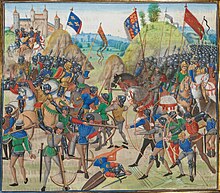

The
Battle of Crécy in 1346, from a manuscript of
Jean Froissart's
Chronicles; the battle established England as a military power.
In the 11th and 12th centuries, constant incursions by nomadic
Turkic tribes, such as the
Pechenegs and the
Kipchaks, caused a massive migration of
Slavic populations to the safer, heavily forested regions of the north.
[55] Like many other parts of
Eurasia, these territories were
overrun by the Mongols.
[56] The invaders, later known as
Tatars, formed the state of the
Golden Horde, which ruled the southern and central expanses of Russia for over three centuries.
[57]
The
Great Famine of 1315–1317 was the first
crisis that would strike Europe in the late Middle Ages.
[58] The period between 1348 and 1420 witnessed the heaviest loss. The population of
France was reduced by half.
[59][60] Medieval Britain was afflicted by 95 famines,
[61] and France suffered the effects of 75 or more in the same period.
[62] Europe was devastated in the mid-14th century by the
Black Death, one of the most deadly
pandemics in human history which killed an estimated 25 million people in Europe alone—a third of the
European population at the time.
[63]
The plague had a devastating effect on Europe's social structure; it induced people to live for the moment as illustrated by
Giovanni Boccaccio in
The Decameron (1353). It was a serious blow to the
Roman Catholic Church and led to increased
persecution of Jews, foreigners,
beggars and
lepers.
[64] The plague is thought to have returned every generation with varying
virulence and mortalities until the 18th century.
[65] During this period, more than 100 plague
epidemics swept across Europe.
[66]
Early modern period
Main article:
Early modern period
See also:
Renaissance,
Protestant Reformation,
Scientific Revolution, and
Age of Discovery

 The School of Athens
The School of Athens by
Raphael: Contemporaries such as
Michelangelo and
Leonardo da Vinci (centre) are portrayed as classical scholars

 Battle of Vienna
Battle of Vienna in 1683 broke the advance of the
Ottoman Empire into Europe
The
Renaissance was a period of cultural change originating in
Florence and later spreading to the rest of Europe. in the 14th century. The rise of a
new humanism was accompanied by the recovery of forgotten
classical Greek and Arabic knowledge from monastic libraries, often re-translanted from Arabic into Latin.
[67][68][69] The Renaissance spread across Europe between the 14th and 16th centuries: it saw the flowering of art, philosophy, music, and the sciences, under the joint patronage of royalty, the nobility, the Roman Catholic Church, and an emerging merchant class.
[70][71][72] Patrons in Italy, including the
Medici family of
Florentine bankers and the
Popes in
Rome, funded prolific
quattrocento and
cinquecento artists such as
Raphael,
Michelangelo, and
Leonardo da Vinci.
[73][74]
Political intrigue within the Church in the mid-14th century caused the
Great Schism. During this forty-year period, two popes—one in
Avignon and one in
Rome—claimed rulership over the Church. Although the schism was eventually healed in 1417, the papacy's spiritual authority had suffered greatly.
[75]
The Church's power was further weakened by the
Protestant Reformation (1517–1648), initially sparked
by the works of German theologian
Martin Luther, a result of the lack of reform within the Church. The Reformation also damaged the Holy Roman Empire's power, as German princes became divided between
Protestant and Roman Catholic faiths.
[76] This eventually led to the
Thirty Years War (1618–1648), which crippled the Holy Roman Empire and devastated much of
Germany, killing between 25 and 40 percent of its population.
[77] In the aftermath of the
Peace of Westphalia,
France rose to predominance within Europe.
[78] The 17th century in southern and eastern Europe was a period of general decline.
[79] Eastern Europe experienced more than 150 famines in a 200-year period between 1501 to 1700.
[80]
The Renaissance and the
New Monarchs marked the start of an
Age of Discovery, a period of exploration, invention, and scientific development.
[81] According to Peter Barrett, "It is widely accepted that 'modern science' arose in the Europe of the 17th century (towards the end of the Renaissance), introducing a new understanding of the natural world."
[67] In the 15th century,
Portugal and
Spain, two of the greatest naval powers of the time, took the lead in exploring the world.
[82][83] Christopher Columbus reached the
New World in 1492, and soon after the Spanish and Portuguese began establishing colonial empires in the Americas.
[84] France, the
Netherlands and
England soon followed in building large colonial empires with vast holdings in Africa,
the Americas, and Asia.
18th and 19th centuries
Main article:
Modern history
See also:
Industrial Revolution,
French Revolution, and
Age of Enlightenment
The
Age of Enlightenment was a powerful intellectual movement during the 18th century promoting scientific and reason-based thoughts.
[85][86][87] Discontent with the aristocracy and clergy's monopoly on political power in France resulted in the
French Revolution and the establishment of the
First Republic as a result of which the monarchy and many of the nobility perished during the initial
reign of terror.
[88] Napoleon Bonaparte rose to power in the aftermath of the French Revolution and established the
First French Empire that, during the
Napoleonic Wars, grew to encompass large parts of Europe before collapsing in 1815 with the
Battle of Waterloo.
[89][90]


Napoleon's Empire in 1811
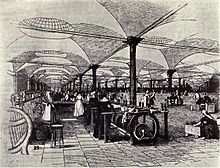

The
Industrial Revolution started in
Great Britain
Napoleonic rule resulted in the further dissemination of the ideals of the French Revolution, including that of the
nation-state, as well as the widespread adoption of the French models of
administration,
law, and
education.
[91][92][93] The
Congress of Vienna, convened after Napoleon's downfall, established a new
balance of power in Europe centred on the five "
Great Powers": the
United Kingdom,
France,
Prussia,
Habsburg Austria, and Russia.
[94]
This balance would remain in place until the
Revolutions of 1848, during which liberal uprisings affected all of Europe except for Russia and the United Kingdom. These revolutions were eventually put down by conservative elements and few reforms resulted.
[95] In 1867, the
Austro-Hungarian empire was
formed; and 1871 saw the unifications of both
Italy and
Germany as
nation-states from smaller principalities.
[96] Likewise, in 1878 the
Congress of Berlin has conveyed formal recognition to the
de facto independent principalities of
Montenegro,
Serbia and
Romania.
The
Industrial Revolution started in
Great Britain in the last part of the 18th century and spread throughout Europe. The invention and implementation of new technologies resulted in rapid urban growth, mass employment, and the rise of a new working class.
[97] Reforms in social and economic spheres followed, including the
first laws on
child labour, the legalisation of
trade unions,
[98] and the
abolition of slavery.
[99] In
Britain, the
Public Health Act 1875 was passed, which significantly improved living conditions in many British cities.
[100] Europe’s population population increased from about 100 million in 1700 to 400 million by 1900.
[101] In the 19th century, 70 million people left Europe in migrations to various European colonies abroad and to the
United States.
[102]
20th century to present
Main articles:
Modern era and
History of Europe
See also:
World War I,
Great Depression,
Interwar period,
World War II,
Cold War, and
History of the European Union
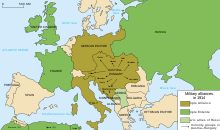

European military alliances just prior to the start of WWI
Two World Wars and an economic depression dominated the first half of the 20th century.
World War I was fought between 1914 and 1918. It started when
Archduke Franz Ferdinand of Austria was assassinated by the
Bosnian Serb Gavrilo Princip.
[103] Most European nations were drawn into the war, which was fought between the
Entente Powers (
France,
Belgium,
Serbia,
Portugal,
Russia, the
United Kingdom, and later
Italy,
Greece,
Romania, and the
United States) and the
Central Powers (
Austria-Hungary,
Germany,
Bulgaria, and the
Ottoman Empire). The War left more than 16 million civilians and military dead.
[104] Over 60 million European soldiers were mobilised from 1914–1918.
[105]
Partly as a result of its defeat Russia was plunged into the
Russian Revolution, which threw down the
Tsarist monarchy and replaced it with the
communist Soviet Union.
[106] Austria-Hungary and the
Ottoman Empire collapsed and broke up into separate nations, and many other nations had their borders redrawn. The
Treaty of Versailles, which officially ended
World War I in 1919, was harsh towards
Germany, upon whom it placed full responsibility for the war and imposed heavy sanctions.
[107]
Economic instability, caused in part by debts incurred in the First World War and 'loans' to Germany played havoc in Europe in the late 1920s and 1930s. This and the
Wall Street Crash of 1929 brought about the worldwide
Great Depression. Helped by the economic crisis, social instability and the threat of communism,
fascist movements developed throughout Europe placing
Adolf Hitler of
Nazi Germany,
Francisco Franco of
Spain and
Benito Mussolini of
Italy in power.
[108][109]
Up to eight million people may have died in the
Soviet famine of 1932–33.
[110] Stalin's
Great Terror began in December 1934. By the time the purges subsided in 1938, millions of Soviet citizens had been executed, imprisoned, or exiled.
[111] In 1933, Hitler became the leader of Germany and began to work towards his goal of building Greater Germany. Germany re-expanded and took back the
Saarland and
Rhineland in 1935 and 1936. In 1938,
Austria became a part of Germany too, following the
Anschluss. Later that year, Germany annexed the German
Sudetenland, which had become a part of
Czechoslovakia after the war. This move was highly contested by the other powers, but ultimately permitted in the hopes of avoiding war and
appeasing Hitler.


Burned-out buildings in
Hamburg, 1944 or 45.
Shortly afterwards, Poland and Hungary started to press for the annexation of parts of Czechoslovakia with Polish and Hungarian majorities. Hitler encouraged the Slovaks to do the same and in early 1939, the remainder of Czechoslovakia was split into the
Protectorate of Bohemia and Moravia, controlled by Germany, and the
Slovak Republic, while other smaller regions went to Poland and Hungary. With tensions mounting between Germany and Poland over the future of
Danzig, the Germans turned to the Soviets, and signed the
Molotov-Ribbentrop Pact. Germany
invaded Poland on 1 September 1939, prompting France and the United Kingdom to declare war on Germany on 3 September, opening the
European theatre of
World War II.
[112][113] The
Soviet invasion of Poland started on 17 September and Poland fell soon thereafter.
On 24 September, the Soviet Union attacked the
Baltic countries and later, Finland. The British hoped to land at Narvik and send troops to aid Finland, but their primary objective in the landing was to encircle Germany and cut the Germans off from Scandinavian resources. Nevertheless, the Germans knew of Britain's plans and got to Narvik first, repulsing the attack. Around the same time, Germany moved troops into Denmark, which left no room for a front except for where the last war had been fought or by landing at sea. The
Phoney War continued.
In May 1940, Germany attacked France through the Low Countries. France capitulated in June 1940. However, the British refused to negotiate peace terms with the Germans and the war continued. By August Germany began a
bombing offensive on Britain, but failed to convince the Britons to give up.
[114] In 1941, Germany invaded the Soviet Union in the ultimately unsuccessful
Operation Barbarossa.
[115] On 7 December 1941
Japan's attack on Pearl Harbor drew the United States into the conflict as allies of the
British Empire and other
allied forces.
[116][117]
After the staggering
Battle of Stalingrad in 1943, the German offensive in the Soviet Union turned into a continual fallback. In 1944, British and American forces invaded France in the
D-Day landings, opening a new front against Germany.
Berlin finally fell in 1945, ending World War II in Europe. The war was the largest and most destructive in human history, with
60 million dead across the world.
[118] More than 40 million people in Europe had died as a result of the war by the time World War II ended,
[119] including between 11 and 17 million people who perished during
the Holocaust.
[120] The
Soviet Union lost around 27 million people during the war, about half of all World War II casualties.
[121] By the end of World War II, Europe had more than 40 million
refugees.
[122] Several
post-war expulsions in Central and Eastern Europe displaced a total of about 20 million people.
[123]
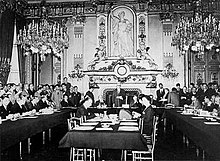

The
Schuman Declaration (
9 May 1950) led to the creation of the
European Coal and Steel Community. It began the
integration process which today comprises the
European Union of 27 democratic countries in Europe
